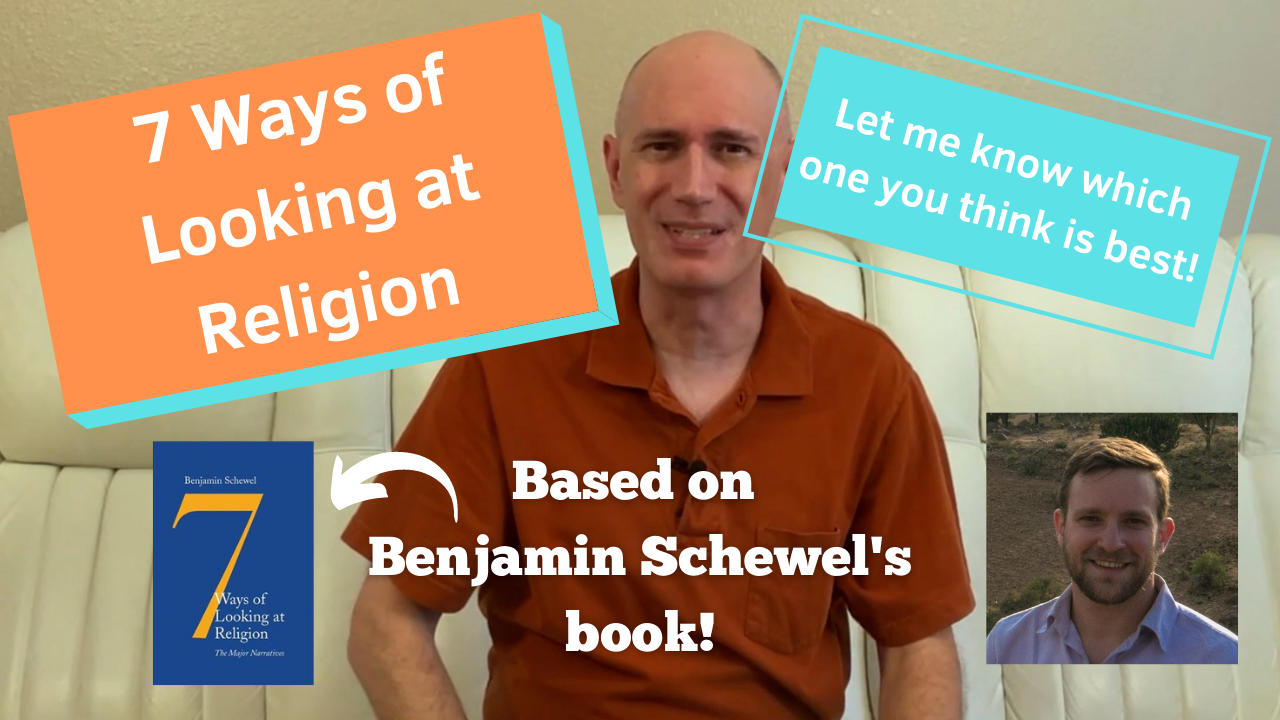12/01/2021 – 7 Ways of Looking at Religion

So, a quick question. How many ways can we interpret religion? We’re going to talk about a guy who says the answer is seven. C’mon now. Let’s get into it. This is TenOnReligion.
Hey peeps, it’s Dr. B. with TenOnReligion. This video is closed-captioned here on YouTube and the transcript is available at TenOnReligion.com. If you like religion and philosophy content one quick thing I need you to do is to smash that sub button because it really helps out the channel. I also have a ko-fi linked in the description if you’d like to help support the channel and help me keep this puppy going.
Benjamin Schewel is a philosopher who works on questions about history and religion. He’s an Associate Fellow at the Institute for Advanced Studies in Culture at the University of Virginia and also a fellow at the Centre for Religion, Conflict and Globalization at the University of Groningen in the Netherlands. I’m not entirely sure what a “fellow” is, but apparently he’s a fellow in two different countries. [Yes, I’m a fellow.] Anywho, he wrote a book based on his dissertation and it came out in 2017 titled, Seven Ways of Looking at Religion: The Major Narratives. We’re going to give a brief overview of the seven narratives and then his conclusion, and then…well…we’ll just see where that takes us.
The seven narratives are the subtraction narrative, the renewal narrative, the transsecular narrative, the postnaturalist narrative, the construct narrative, the perennial narrative, and the developmental narrative. Each chapter on the narratives first explains the narrative and then provides three figures as representative of that narrative followed by some analysis of the narrative by the author. I’m going to mention who the three figures are in each chapter, but we clearly don’t have time to explain each of their positions and why or how they are representative of that narrative, so if you want the details on all that, you’ll just have to get the book and read it for yourself.
Ok, let’s get started. First, the subtraction narrative. Its central premise is that religion originally arose as a way of dealing with ignorance, powerlessness, and cultural passivity that plagued early human existence. As we have acquired more knowledge, power, and cultural dynamism, however, we have rightfully become less religious. Subtraction narratives use this logic to equate modernization with the marginalization and decline of religion such that a fully “modern” society would have hardly any religion at all. Basically, the more modern we are, the less religious we should be. The three figures mentioned are Daniel Dennett, John Dewey, and Marcel Gauchet. The problem with this narrative is that empirical analysis suggests there is little evidence that religion declines as science, technology, capitalism, democracy, education, and the principles of freedom and equality spread. Those who espouse the subtraction narrative answer this by claiming that religion spreads among vulnerable populations as a way of coping with threats they have no control over such as poverty and inequality. It’s unclear if this is the reason that religions still flourish or if another interpretation better explains the empirical data.
Second, the renewal narrative which is kind of the opposite of the subtraction narrative. The decline of an earlier religious tradition caused the problems in the modern world and we can solve these problems only by renewing this tradition today. The three figures cited are Alasdair MacIntyre (virtue tradition), Martin Heidegger (early Greek thought), and the Islamic poet/philosopher Muhammad Iqbal (return to a golden age of Islam). The problem for renewal narratives is how to explain why the modern West has advanced so remarkably despite the decline of the ideal religious orientation. One could ask why those previous epochs were so good and why only that solution would work in today’s context. If something novel entered into society back then, why could not something equally as novel enter into today’s society to transform it? Or more succinctly, why look to the past instead of the future?
Third, the transsecular narrative. The forces of modernity do not directly cause religion’s marginalization and decline, but rather stimulate its transformation. Societal change is broader, and religion is but one component or factor. The three figures are Charles Taylor, Rodney Stark, and Jeffrey Stout. This narrative really focuses on Western modernity though, and the critique is whether or not it’s just too Western-centric. Perhaps we should be talking about “multiple modernities” as opposed to just a Western one. Not just the U.S. and Europe, but China, Saudi Arabia, India, Brazil, African countries and so on.
Fourth, the postnaturalist narrative. Modern interpreters of natural science were falsely led by anti-religious sentiment and a problematic desire to turn modern science into a complete metaphysical system to claim that accepting modern science entails accepting naturalism. Nevertheless, critical philosophical analyses [analyseses…analysesss] of naturalism and recent developments in natural science have helped reclarify how certain spiritual concepts are consistent with a scientific worldview. Postnaturalist narratives also uniquely argue that embracing modern science does not rule out religious convictions; it simply forces us to deepen and modify our understanding of religions’ claims. This is sort of a variant on the transsecular narrative, but since science is such a dominant factor, the author claims it deserves its own specific attention. The three figures are Thomas Nagel, Hans Jonas, and Alfred North Whitehead. Arguments from the perspective of a postnaturalist narrative are attempts to critique naturalism and to consider how certain spiritual concepts can be reasonably reincorporated into a scientific worldview. This seems similar to what Wesley Wildman was talking about in his book Religious Philosophy as Multidisciplinary Comparative Inquiry. You can check out my episode I recently did on this. I also might do a future episode on Ian Barbour who did an excellent job on framing the possible relationships between science and religion, so stay tuned.
Fifth, the construct narrative. Construct narratives describe how a distinctive concept of “religion in general” arose during the modern period and consider whether this concept is an illusion, a discovery, a political project, or some mix of all three. The figures mentioned are Talal Asad, Guy Stroumsa, and Jason Josephson who uses Japanese religions as a great example. The classical figures on this are Edward Said and Tomoko Masuzawa and I’m a little confused on why they weren’t mentioned here. The problem with this narrative is that religion gradually became a secularized concept being judged by non-religious, secular ethics, but religions themselves are not like this. Yet, to choose one religion’s idea of what religion is and use that as the norm by which to interpret all other religions is similarly problematic. So, the question is, can religions work together in a constructive fashion to create a notion of religion rather than let non-religious conceptual schemes supply the definition for them? Hard to say.
Sixth, the perennial narrative. The perennial narrative claims that all religions exhibit common characteristics. All the world’s religions conceptualize the same spiritual reality but just do it differently. The figures are Aldous Huxley, John Hick, and Rudolf Otto. The problem is, all religions are obviously not the exact same things, so how can the idea of perennial narrative perspectives on religion be engaged without collapsing all religious difference into an easy unity? The perennial narrative perspective suggests one way is to focus on the idea of transcendence and see how seemingly differing religions understand and connect to transcendence.
Seventh, the developmental narrative. Developmental narratives argue that the broader arc of religious history exhibits a staged process of development and growth. The figures are G. W. F. Hegel, Karl Jaspers, and Robert Bellah. The obvious question here is what does “development” amount to? Sometimes “development” is used to describe neutral processes of maturation and growth while other times it is used to describe ideal patterns of maturation and growth, meaning necessarily progressing or advancing. Hegel is more evolutionary while Jaspers and Bellah are more neutral. However, even in Bellah’s neutral development approach, once a new era or way of thinking about religion appeared, there was no going back to the old way. The development was irreversible. The evolutionary interpretation of development is more problematical because it can easily lead to what Schewel terms “triumphalism” or “supersessionism” whereby anything that came before it becomes moot and irrelevant or even bad or evil. Clearly each new era of religious history is not immediately better than what came before it though. One question one could ask about this narrative is, should this vision of religious history commit us to the claim that some religious practices and beliefs are more suited for a given period of history than others? That’s tricky.
In the concluding chapter, Schewel states that there are three ways to analyze the overall project of describing and making sense of these seven narratives: (1) Each narrative is a competing research program that must vie against the others until one reigns supreme. (2) Each narrative is a kind of methodological heuristic that can be used to analyze distinctive religious phenomena. (3) Integrate the insights of all seven narratives into a meta-narrative whole. The first option is not good because each narrative illuminates an aspect of interpreting religion that the others do not contain. The second option, when applied separately to one tradition, for example, can be used in a positive manner to analyze religion from a variety of angles. But this still keeps the narratives rather “siloed” from each other where the narratives and their resulting interpretations do not really interact with each in any meaningful way. The third option of attempting to somehow integrate all seven narratives could proceed in one of two ways. Either create an all-encompassing eighth narrative and put all of them there or modify one of the seven existing narratives so that it can somehow accommodate all of the other six. The author believes the second option is the best, and even further, that the developmental narrative is the most promising option to accomplish this and proceeds to sketch out a potential conceptual framework to do this in this final chapter. But is choosing the developmental narrative as the overall framework too optimistic when it is projected into the future? Not sure.
Okay, listen to a quick summary of the seven narratives and let me know which one you think has the most promise for interpreting religion. Subtraction narratives illumine how many features of earlier religious epochs decline as humanity’s knowledge and power reach new levels of complexity and scope. Renewal narratives explain that not all subtractions are beneficial and argue that society would benefit by creatively reengaging certain older religious practices and beliefs. Transsecular narratives show that the forces of modernity do not stimulate religion’s wholesale marginalization and decline, but rather facilitate its transformation. Postnaturalist narratives trace how modern science disrupted premodern views of nature, but now, after many years of overzealous association with naturalism, is beginning to help us consider certain spiritual realities anew. Construct narratives describe how a distinctive concept of “religion in general” developed in the modern West and was then applied to non-Western and premodern peoples. Perennial narratives highlight the common characteristics of diverse systems of religious practice and belief. And finally, developmental narratives explore the various stages through which religion has historically evolved.
So, which narrative do you like the most and why? Leave a comment below. Until next time, stay curious. If you enjoyed this, support the channel in the link below, please like and share this video and subscribe to this channel. This is TenOnReligion.


